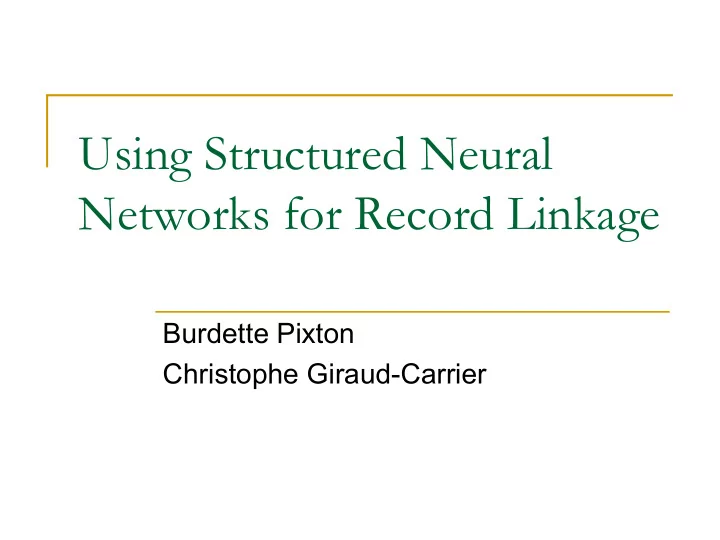

Using Structured Neural Networks for Record Linkage Burdette Pixton Christophe Giraud-Carrier
Record Linkage � Record Linkage is: � the process of identifying similar people � a necessary step in exchanging and merging pedigrees
Record Linkage – General Process � General Process � Compare attributes � Surname A vs. Surname B � Use String Metrics (jaro, soundex, etc..) � Quantify the comparison (score) � Rule-based � Use metric score � Combine the scores � Rule-based � Neural Network � Compare against a threshold
MAL4:6 � Mining And Linking FOR Successful Information eXchange � An automatic approach � MAL4:6 uses relationships found in pedigrees � Traverses both pedigrees in parallel and measures the similarity of each instance � Individual A vs Individual B and Father A vs Father B , etc…
Version 0.1 � Focused on � Comparing the attributes � Quantifying the comparison � Naively � Combined the scores (Average) � Compared against a threshold
Version 0.1 Attribute Metric Type Gender Binary � Similarities are Discrimination computed using a Name Soundex heterogeneous metric system Location Jaro Day 1-norm Month Dice Year 1-norm
Version 0.1 Definitions � Attributes: A = {A 1 ,A 2 ,…A n }, A i would be a piece of information (e.g., date of birth) � For each A i , sim Ai is the similarity metric associated with A i � Let x = < A 1 : a 1x , A 2 : a 2x,…, A n : a nx > denote an individual where a jx is the value of A j for x � <firstname: John, lastname: Smith,…> � Let R= {R 0 ,R 1 ,…R m } be a set of functions that map an individual to one of its relatives � α ij = {0,1}
Version 0.1 � Matches: � Recall = 94.2%, Precision = 71.8% � Mismatches � Recall = 86.2%, Precision = 98.4%
Version 0.1 Challenges � Each relationship/attribute is treated equally � Weights � Version 0.1 used feature selection instead of continuous weights � Weights would allow MAL4:6 to use all of the data in a pedigree to a degree (TBD by MAL4:6) � Naturally Skewed Data � #NonMatches >> #Matches � Learners tend to over learn the majority class
Version 1.0 Definitions Problem 1: Each relationship/attribute is treated equally � Attributes: A = {A 1 ,A 2 ,…A n }, A i would be a piece of information (e.g., � date of birth) For each A i , sim Ai is the similarity metric associated with A i � x > denote an individual where a j Let x = < A 1 : a 1 x , A 2 : a 2 x,…, A n : a n x � is the value of A j for x � <firstname: John, lastname: Smith,…> Let R= {R 0 ,R 1 ,…R m } be a set of functions that map an individual to � one of its relatives � ω i and α ij are continuous
Structured Neural Network Learning Weights (Problem 2) Match MisMatch ω i Spouse Individual Father Weights α ij Similarity Scores
Blocking/Filtering � Problem 3: Naturally Skewed Data � Blocking � Typically done on preprocessed data to reduce obvious non-matches � Extended Blocking/Filtering � Use a series of structured neural networks � After each training-testing phase (pass), eliminate “obvious” instances of the majority class
Filtering Definitions � Let T = M ∪ m be the training set, where M is the set of pairs from the majority class and m is the other class � MATCH( x ) is the value of the match output node when x is presented � MISMATCH( x ) for the mismatch output node
Filtering Definitions � If q is a pair to be classified, then its ratio r is � Thresholds
Filtering Definitions � If match is the majority class ( M ) � An instance is classified as a match if r > δ M � If mismatch is the majority class ( M ) � An instance is classified as a mismatch if r < δ M � Remaining instances are inputted into a new structured neural network � When a test instance is classified � True/false positive/negative rates are calculated � These rates are propagated to future networks � Each element is classified � Elements between the thresholds are classified as M � Rates from previous networks are computed with current rates to obtain overall performance indicators
Experimental Setup � Genealogical database from the LDS Church’s Family History Department (~5 million individuals) � ~16,000 labeled data instances � Created a training set and test set for distributions of 1:1 and 1:100 � Pre-blocked (each instance is “close”) � 1:100 not likely to occur but used for experimental purposes
Balancing the distributions Original Pass 1 Pass 2 Pass 3 Pass 4 Pass 5 1:100 1:79.7 1:28.9 1:3.18 --- --- 1:1 1:.042 1:4.45 1:2.59 1:1.42 1:2.47
Precision/Recall No Pass Pass Pass Pass Pass Filtering 1 5 2 3 4 1:100 25.0/ 70.0/ 44.4/ 44.4/ -- -- 33.3 33.3 85.7 85.7 1:1 80.3/ 91.6/ 91.4/ 88.0/ 88.6/ 88.9/ 81.6 85.7 86.7 94.0 93.5 93.8
0.1 vs. 1.0 Version 0.1 Version 1.0 Distribution 1:3 1:1 Generations 8 (4 up, 4 down) 3 (3 up) Precision 71.8% 88.9% Recall 94.6% 93.8%
Future Work � Structured Neural Networks allow us to look into the “why” � Compare networks at different distribution layers
Recommend
More recommend